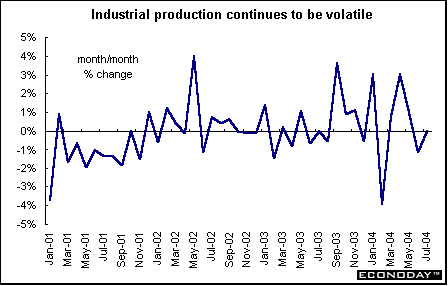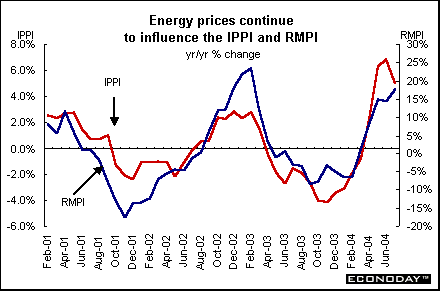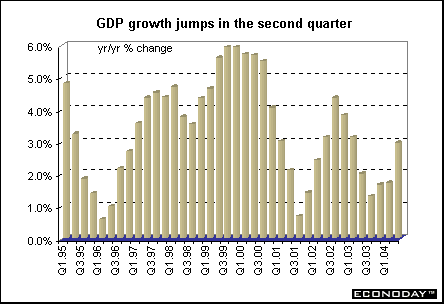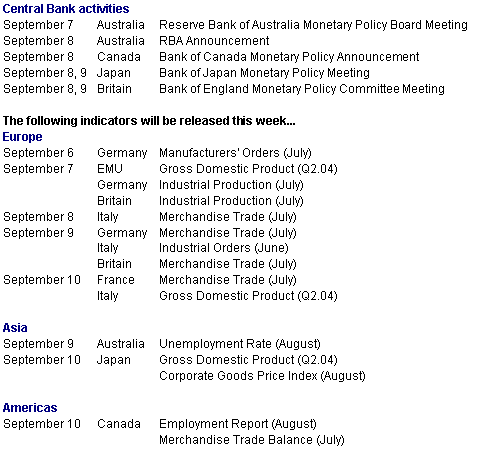Monday, September 6, 2004

A very brief survey of Q2 GDP
All members of the Group of Seven have finally released second quarter GDP data. On a year over year basis, the U.S. barely edged Japan as the fastest growing member even though both grew slower in the second quarter than in the first. While growth slowed in the U.S. and Japan, it improved for the other five members with Italy and Germany clearly the laggards. While consumers did their part in the U.S., Britain, Canada and France, that is not the case for the others. Japan's deflation-afflicted economy continues to grow thanks to exports, though there is some sign that the consumer just might be beginning to spend. But that is not the case in Germany, where unemployment is high and getting higher, and in Italy, where there is little stimulus to spend.

The ECB does the expected
The European Central Bank returned from vacation on Thursday and did the expected: it left its policy interest rate unchanged at 2 percent - where it has been since June 5, 2003. Both money supply growth and inflation continue to be above the Bank's targets of 4.5 percent and 2 percent respectively. The latest readings were 5.2 percent and 2.3 percent. The EMU trails other developed economies in economic growth by a wide margin, making any ECB rate increase unlikely any time soon. The Governing Council had new staff forecasts to consider at the meeting. The forecasts for both the harmonized index of consumer prices (HICP) and GDP were raised from June's estimates. The HICP is expected to continue to be above the ECB's 2 percent inflation target and increase by 2.2 percent in 2004. The GDP growth forecast was increased to 1.9 percent for 2004 from the June forecast of 1.7 percent.
Global Markets
With summer over, all the tried and true August excuses for market behavior are also gone. However, last week combined two factors that influenced investors - the last week of summer and the days immediately before the U.S. employment situation report. Other diversions were available as well, including the Republican National Convention, along with the terrorism concerns surrounding it, and continuing swings in oil prices. Trading volume was sparse in virtually all markets. Investors appeared to take less than satisfying economic news in their stride while not responding to upbeat news. On the week, of the thirteen indexes followed here three declined - the Nikkei, Topix and Nasdaq. For the year to date, only the DAX, Dow, and Nasdaq are below their 2003 year-end levels.
Global Stock Market Recap

Europe and Britain
While stocks were up on the week, volume again was low. Those investors not on vacation sat on the sidelines and waited for Friday's U.S. employment report. And when jobs increased 144,000 - close to consensus estimates - and the unemployment rate dipped to 5.4 percent, stocks here responded more positively than those in the U.S. Despite a plethora of weaker economic data earlier in the week indicating the growth soft spot in the U.S. and elsewhere might last a little longer, European and British equities ended the week on a positive note.

Investor reactions can produce a shrug of the shoulders occasionally. Rising crude oil prices acted as a depressant for investors recently. But on Thursday, investors treated a spike in crude oil prices as a positive rather than a negative factor. Investors decided to buy oil company stocks on prospects of higher profits.
Asia/Pacific
Asian/Pacific stocks drifted in the week. With little in the way of domestic economic market moving news to provide direction, shares in Japan were down on the week as investors focused on U.S. economic news that mainly showed the second quarter soft patch might extend into the third. Technology stocks seesawed during the week while auto stocks lost ground after disappointing sales figures from the U.S. But on Friday, declines in technology stocks pushed the Tokyo stock market lower after Intel warned of weak demand for consumer electronics products in the current quarter. Intel is the bellwether of the technology industry so any significant slowdown in their earnings momentum is a big disappointment.

Currencies
The dollar rallied Friday for two major reasons - the realization that the Republican Convention in New York City had passed uneventfully and the U.S. employment report data were close to consensus forecasts. The dollar was up against the euro on the week after the U.S. employment situation report almost met expectations and eased concern about the duration of a slowdown in economic growth. The dollar extended its advance after the ISM services index showed a 16th consecutive month of expansion even though it was at a much slower pace than in July. Friday's employment figures follow two months of job creation that fell short of forecasts and eroded demand for the dollar. The dollar had been down on the week after data showed consumer confidence slipping and the pace of expansion in manufacturing slowing.

The yen traded within a very narrow band for four of the five days last week. However, the U.S. employment report stimulated dollar buying and the yen ended Friday lower both for the day and the week. The yen was down on the week because of declines in Japanese stocks, which in turn eased demand for yen.

Indicator scoreboard
EMU - July seasonally adjusted unemployment rate remained at 9 percent for the fourth month. Of the nine countries reporting data, unemployment was unchanged in seven but was higher in two. Spain continues to have the highest unemployment rate - 11 percent - with Germany trailing with a 9.9 percent rate.

August manufacturing purchasing managers' index retreated to 53.9 from 54.7 in July. Output and export orders slowed while high raw materials prices continued to squeeze profit margins. The data are compiled monthly by NTC Research. An index reading above 50 indicates growth, while anything under 50 indicates a decline. The indexes for Germany, France, Italy and Britain were down as were the indexes for Japan and the U.S., which are added to the graph below for comparative purposes.

August purchasing managers' services index slipped to 54.5 from 55.3 in July. New order growth slowed to a four-month low and back orders retreated, reflecting softer global growth. Higher commodity prices boosted input prices to the fastest pace in 45 months. In most large countries, firms were unable to pass on higher costs to customers. Coupled with the slowdown in industry growth, the Reuters' composite eurozone index dipped to 55.0 from 56.0 in July.

August flash harmonized index of consumer prices was up 2.3 percent when compared with August of 2003. Eurostat does not release data for components or a monthly change figure in the flash release.

July producer price index was up 0.4 percent and 2.8 percent when compared with last year. The increase was largely due to higher energy prices. Energy prices jumped 1.1 percent and 5.1 percent on the year. Excluding energy, the PPI was up 0.2 percent and 2.2 percent on the year.

July seasonally adjusted retail sales were up 0.4 percent and 1.1 percent when compared with last year. Food, drink and tobacco sales were up 0.7 percent while non-food sales were flat. The data are based on information from only four of 12 member countries.

Germany - July Bundesbank seasonally adjusted retail sales jumped 1.5 percent but were down 1.9 percent when compared with last year. Excluding autos and gasoline stations, retail sales were up a modest 0.3 percent but dropped 0.9 percent on the year.
August seasonally adjusted unemployment rate remained at 10.6 percent. The unemployment rate in east Germany remained at 18.6 percent but edged up in the west to 8.6 percent from 8.5 percent in July and 8.4 percent in June. The number of seasonally adjusted unemployed was up in both the east and the west.

France - July seasonally adjusted unemployment rate edged down to 9.8 percent from 9.9 percent in June according to the International Labour Organization's measure of unemployment which excludes job seekers who did any work during the month. The number of unemployed persons dropped by 10,000 in July. Underlying unemployment trends have been skewed by political factors since the start of this year.

Italy - July producer price index was up 0.3 percent and 3.3 percent when compared with last year. Energy prices were up 1.0 percent and 3.8 percent on the year. Excluding energy, the PPI was up 0.2 percent and 3.2 percent on the year.
June merchandise trade deficit with the rest of the world was �1.071 billion. In May, the trade balance was a surplus of �207 million. Exports were up 14 percent and imports were up 16.3 percent when compared with June 2003.
Britain - August Halifax house price index dropped 0.6 percent but was up 19.3 percent when compared with the same month in 2003. The monthly decline was the first since August of 2002. The Halifax said that the five interest rate hikes by the Bank of England since November of 2003 were now acting as a damper on house price growth.

Asia
Japan - July seasonally adjusted industrial production was unchanged and was up 5.9 percent when compared with the previous year. Production is slowing as companies reduce inventories and as sales of digital consumer products cool after the Summer Olympics. The government, which includes forecasts in the report, thinks that production will increase by 1.5 percent in August and will gain another 0.6 percent in September.

Australia - Second quarter gross domestic product was up 0.6 percent and 4.1 percent when compared with the same quarter last year. It was the 14th consecutive quarter the economy has expanded. Household spending was up 1.1 percent. Housing investment increased 1.1 percent while government spending gained 1.9 percent in the second quarter. Exports were up 1.8 percent and imports gained 2 percent. The chain price index, a measure of price changes in the economy, climbed 1 percent in the second quarter. Business investment increased 4.9 percent while company profits surged 10.3 percent in the second quarter from the previous three months, the largest increase in four years.

Americas
Canada - July industrial product price index (IPPI) was down 0.4 percent but jumped by 5.0 percent when compared with July 2003. Lower motor vehicles and other transport equipment prices, which were down 1.8 percent, contributed to more than half of the monthly decrease. This was mainly the result of the effect of the exchange rate. The petroleum and coal products group continued to have a strong influence on the 12-month change with an increase of 24.1 percent. If petroleum and coal product prices had been excluded, the IPPI would have increased 3.8 percent on the year.

July raw materials price index (RMPI) was up 0.9 percent and 17.7 percent when compared with last year. Mineral fuels were mostly responsible for the July gain, with an increase of 1.9 percent. Crude oil prices rose 3.5 percent as a result of supply uncertainties and increased demand. Ferrous materials were up 10.9 percent as a result of higher prices for iron and steel scrap. On the year, mineral fuels were up 18.8 percent from a year ago with crude oil prices rising 24.3 percent. If mineral fuels had been excluded, the RMPI would have increased 16.7 percent.
Between June and July, the value of the U.S. dollar fell 2.6 percent against the Canadian dollar. As a result, the total IPPI excluding the effect of the exchange rate would have risen 0.4 percent compared with the 0.4 percent actual decline. On the year, the change in the IPPI excluding the effect of the exchange rate was 6.5 percent from July 2003 to July 2004, compared with the 5.0 percent actual increase.
Second quarter gross domestic product was up 1.1 percent and 3 percent when compared with last year as surging exports helped boost growth in manufacturing, wholesaling and rail and truck transportation. Consumer spending growth, which makes up 57 percent of the economy, slowed to 0.3 percent from 1.6 percent in the first quarter. Exports rose 5.0 percent, faster than the 3.2 percent rise in imports. Business investment in plant and equipment advanced 1.0 percent. The chain price index was up 1.4 percent, the fastest pace in five quarters. Overall, the Canadian economy grew at an annualized 4.3 percent in the second quarter of 2004, compared with an annualized 2.8 percent for the U.S. economy.

Bottom line
While the investors were besieged with new economic data all last week, they were really waiting for only one report - and that is of course the U.S. employment situation report which came in pretty much as expected. This helped boost the dollar initially and equity indexes in Europe. (As usual, the Asian/Pacific indexes won't react until Monday.) This week will provide another hefty dose of new economic information as well as a plethora of central bank meetings and announcements to dissect including those from England, Japan, Canada and Australia.
Summer is indeed over.
Looking Ahead: September 6 through September 10, 2004




